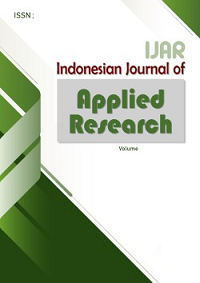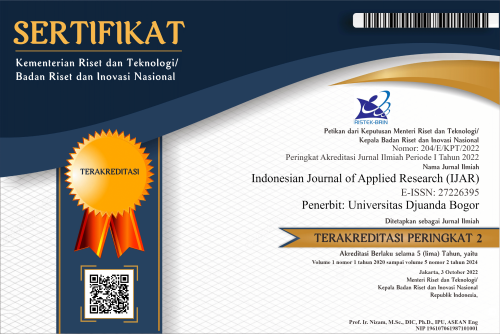The Effect of Temperature and Concentration Edible Coating of Aloe Vera Gel (Aloe Vera L.) to The Shelf Life and Sensory of Tomatoes (Solanum lycopersicum L. cv Momotaro)
Abstract
Tomatoes (Solanum lycopersicum L. cv Momotaro) with a creeping growth or indeterminate type generally grown in the highlands have high economic value. Momotaro tomatoes were classified as climacteric fruits that are easily damaged after harvest. So, it is necessary to do low-temperature treatment and edible Aloe vera gel coating to extend shelf life and sensory. This research aims to determine the effect of low-temperature storage and the concentration of aloe vera gel edible coating, which can extend the shelf life and sensory of Momotaro tomatoes. This study used a complete randomized design of the nested pattern, with treatment edible coating aloe vera gel consisting of 3 concentrations, namely control treatment (without coating), concentration coating 50%, concentration coating 100% nested in temperatures 5°C, 10°C, 15°C, and room temperature (27°C). Conclusions from results showed that the temperature treatment of 10°C and the edible coating treatment of aloe vera gel with a concentration of 50% nested at 10°C, have better results in extending the shelf life and sensory of Momotaro tomatoes to more than 30 days because the maturity level of Momotaro tomatoes has not yet reached its chemical peak. The temperature treatment and concentration of aloe vera coating positively contribute to extending the shelf life and sensory of Momotaro tomatoes.
References
REFERENCES
Aisyah, A. D., Novita, D. D., & Tamrin. (2022). Pengaruh coating ekstrak daun cincau hijau (Cyclea Barbata L.) dan suhu penyimpanan terhadap perubahan fisik tomat (Solanum lycopersicum L.) selama penyimpanan. Jurnal Agricultural Biosystems Engineering, 1(3), 392–400.
Aminudin, & Nawangwulan. (2014). Pengaruh edible coating gel lidah buaya (aloe vera L.) terhadap mutu dan umur simpan mentimun. Jurnal Ekologia, 14(1), 1–12.
Anto, Y. (2021). Lezatnya pasar tomat ekslusif momotaro. Budidaya Tani. https://www.budidayatani.com/2021/09/lezatnya-pasar-tomat-eksklusif-momotaro.html?m=1
Asgar, A. (2017). Pengaruh Suhu Penyimpanan dan Jumlah Perforasi Kemasan Terhadap Karakteristik Fisik dan Kimia Brokoli (Brassica oleracea var. Royal G). Jurnal Hortikultura, 27(1), 127–136. https://doi.org/10.21082/jhort.v27n1.2017.p127-136
Ashadi, R., Netty, & Alimuddin, S. (2022). Pengaruh suhu dan jenis kemasan terhadap daya simpan dan kualitas buah tomat (Solanum Lycopersicum L.). Jurnal AgrotekMAS, 2(3), 19–28. https://doi.org/prefix 10.33096
Asjulia, & Dyan, A. (2023). Pengaruh suhu dan jenis kemasan terhadap daya simpan dan kualitas buah tomat. Jurnal Agroecotech, 2(1), 42–49. https://doi.org/10.59638/jai.v2i01.35
Darmawan, M., Mutia, A. K., & Arifin, T. H. (2022, October). Pengaruh Lapisan Lidah Buaya (Aloe vera L.) dengan Penambahan CMC (Carboxy Methyl Cellulose) Yang Berbeda Terhadap Daya Simpan Buah Tomat (Lycopersicon esculentum) di Suhu Refrigerator. In PROSIDING SEMINAR NASIONAL AGRIBISNIS (Vol. 2, No. 1).
Deglas, W. (2023). Pengaruh Suhu Penyimpanan dan Tingkat Kematangan terhadap Umur Simpan Buah Tomat. Jurnal Ilmu Pangan Dan Hasil Pertanian, 7(1), 49–60. https://doi.org/10.26877/jiphp.v7vi1i.15460
Dewi N.W.P., Pudja A.R.P., & Kecana P.K.D., (2021). Pelapisan gel aloe vera (Aloe barbadensis Miller) dan ekstrak jahe pada buah tomat (Lycopersicum esculentum Mill). Jurnal BETA (Biosistem Dan Teknik Pertanian), 9(1), 56–65. https://doi.org/10.24843/jbeta.2021.v09.i01.p06
Fitriani, H. P., & Haryanti, S. (2016). Pengaruh penggunaan pupuk nanosilika terhadap pertumbuhan tanaman tomat (Solanum lycopersicum) var.Bulat. Buletin Anatomi Dan Fisiologi, 24(1), 34–41.
Garcia, M. A., Ventosa, M., Diaz, R., Falco, S., & Casariego, A. (2014). Effects of Aloe vera coating on postharvest quality of tomato. Fruits, 69(2), 117–126. https://doi.org/10.1051/fruits/2014001
Handarini, K. (2021). Lidah Buaya (Aloe vera) sebagai Edible Coating pada Cabai Merah (Capsicum annuum) dan Tomat (Lycopersicum esculentum). Jurnal Agroscience, 11(2), 157–169. https://doi.org/10.35194/agsci.v11i2.1847
Hutapea, W. D. (2014). Analisis Laju Respirasi Buah Tomat (Lycopersicum Esculentum Mill) Terlapisi Larutan Kitosan Dengan Variasi Konsentrasi Aditif (Doctoral dissertation, Universitas Gadjah Mada).
Karmida, Hayati, R., & Marliah, A. (2022). Pengaruh lama pencelupan dengan edible coating gel lidah buaya (Aloe vera) dan lama simpan terhadap kualitas cabai rawit (Capsicum frutescens L.). Jurnal Floratek, 17(2), 80–97.
Kulshrestha, K., & Srivastava, S. (2013). Nutritional content and significance of tomato powder. Annals of Arid Zone, 52(2), 121–124.
Marpaung, D. A., Susilo, B., & Argo, B. D. (2015). Pengaruh penambahan konsentrasi CMC dan lama pencelupan pada proses edible coating terhadap sifat fisik anggur merah ( Vitis vinifera L .). Jurnal Keteknikan Pertanian Tropis Dan Biosistem, 3(1), 67–73.
Marwina, R., Agustina, R., & Putra, B. S. (2016). Perubahan mutu tomat (Lycopersicon esculentum Mill.) dengan variasi konsentrasi pelapisan gel lidah buaya (Aloe vera L.) dan suhu penyimpanan. Jurnal Ilmiah Mahasiswa Pertanian Unsyiah, 1(1), 985–994. https://doi.org/10.17969/jimfp.v1i1.1190
Moirangthem, K., & Tucker, G. (2018). How do fruits ripen. Frontiers for Young Minds, 6(16), 1–7. https://doi.org/10.3389/frym.2018.00016
Nasution, R. S., Yahya, H., & Harahap, M. R. (2019). Pengaruh karaginan dari rumput laut merah (Eucheuma cottonii) asal Provinsi Aceh sebagai edible coating terhadap ketahanan buah. Al-Kimia, 7(2), 100–112. https://doi.org/10.24252/al-kimia.v7i2.6385
Nisa, A., (2020). Peningkatan Produksi Tomat Momotaro dengan Pemanfaatan Teknologi Rain Shelter pada Gapoktan Mujagi Kabupaten Cianjur. Institut Pertanian Bogor.
Prastya O., Utama, & Yulianti. (2015). Pengaruh pelapisan emulsi minyak wijen dan minyak sereh terhadap mutu dan masa simpan buah tomat (Lycopersicon esculentum Mill). Jurnal BETA, 3(1), 1–10.
Roiyana, M., Izzati, M., & Prihastanti, E. (2012). Potensi dan efisiensi senyawa hidrokoloid nabati sebagai bahan penunda pematangan buah. Buletin Anatomi Dan Fisiologi, 20(2), 40–50. https://doi.org/https://doi.org/10.14710/baf.v20i2.4771
Rusmanto, E., Rahim, A., & Hutomo, S. (2017). Karakteristik fisik dan kimia buah tomat hasil pelapisan dengan pati talas. Agrotekbis: E-Jurnal Ilmu Pertanian, 5(5), 531–540.
Saiduna., & Madkar, O. R. (2013). Pengaruh suhu dan tingkat kematangan buah terhadap mutu dan lama simpan tomat (Lycopersicum esculentum Mill). Jurnal AGROSWAGATI, 1(1), 43–50.
Specialty Produce. (2023). Momotaro Tomato. Specialty Produce. https://specialtyproduce.com/produce/momotaro_tomato_2299.php
Sugiarti, L., Mubarok, S., & Kusumiyati. (2021). Pengaruh kombinasi konsentrasi 1-methylcyclopropene dan asam askorbat terhadap kualitas ketahanan simpan pascapanen buah tomat beef (Valoasis RZ). Jurnal Agrikultura, 32(1), 1–6. https://doi.org/10.24198/agrikultura.v32i1.30475
Tarigan, N. Y. S., Utama, I. M. S., & Kencana, P. K. D. (2016). Mempertahankan mutu buah tomat segar dengan pelapisan minyak nabati. Jurnal BETA (Biosistem Dan Teknik Pertanian, 4(1), 1–9.
Tea, M. T. D., & Adu, R. E. Y. (2022). Penerapan Edible Coating Berbahan Gel Aloe Vera Untuk Meminimalisir Kerusakan Buah Tomat Di Kelompok Tani Oemanas, Desa Nian, Kabupaten Ttu. Jurnal Pasopati: Pengabdian Masyarakat dan Inovasi Pengembangan Teknologi, 4(4).
Utama, I. M. S., & Antara, S. N. (2013). Pasca Panen Tanaman Tropika: Buah dan Sayuran (Post Harvest of Tropical Plant Products: Fruit and Vegetable). Tropical Plant Curriculum Project. Bali (ID): Udayana University.
Wulandari, D., & Ambarwati, E. (2022). Laju respirasi buah tomat (Lycopersicon esculentum Mill.) yang dilapisi dengan kitosan selama penyimpanan. Jurnal Vegetalika, 11(2), 135–150. https://doi.org/10.22146/veg.53561
Yuniastri, R., Ismawati, Atkhiyah, V. M., & Al Faqih, K. (2020). Karakteristik kerusakan fisik dan kimia buah tomat. Journal of Food Technology and Agroindustry, 2(1), 1–8. https://doi.org/10.24929/jfta.v2i1.954
Copyright (c) 2023 Indonesian Journal of Applied Research (IJAR)

This work is licensed under a Creative Commons Attribution-ShareAlike 4.0 International License.
The Authors submitting a manuscript do so on the understanding that if accepted for publication, copyright publishing of the article shall be assigned/transferred to Indonesian Journal of Applied Research (IJAR) Universitas Djuanda as Publisher of the journal. Upon acceptance of an article, authors will be asked to complete a 'Copyright Transfer Agreement'. An e-mail will be sent to the corresponding author confirming receipt of the manuscript together with a 'Copyright Transfer Agreement' form by online version of this agreement.
Indonesian Journal of Applied Research (IJAR) Universitas Djuanda, the Editors and the Editorial Board make every effort to ensure that no wrong or misleading data, opinions or statements be published in the journal. In any way, the contents of the articles and advertisements published in the Indonesian Journal of Applied Research (IJAR) Universitas Djuanda are sole and exclusive responsibility of their respective authors and advertisers.
Remember, even though we ask for a transfer of copyright, our journal authors retain (or are granted back) significant scholarly rights as mention before.
The Copyright Transfer Agreement (CTA) Form can be downloaded here: Copyright Transfer Agreement-IJAR 2020
The copyright form should be signed electronically and send to the Editorial Office e-mail below:
Prof. Dr. Ir. Dede Kardaya, M.Si. (Editor-in-Chief)
Universitas Djuanda
Jl. Tol Jagorawi No.1, Ciawi, Kec. Ciawi, Bogor, Jawa Barat 16720
Website: http://journal.unida.ac.id/index.php/IJAR/index
Email: ijar@unida.ac.id






 This work is licensed under a
This work is licensed under a 